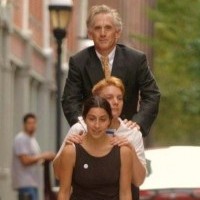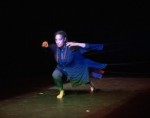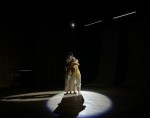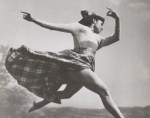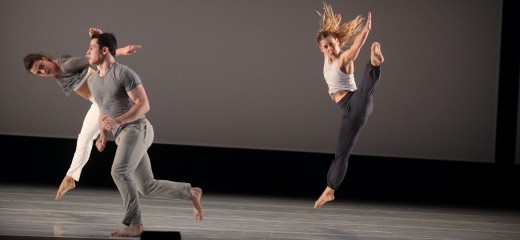
Photo: Julieta Cervantes
Nyet, Sochi Olympics. Da, Liz Gerring’s glacier!
by Jonathan Stein
Liz Gerring talks to Jonathan Stein of thINKingDANCE before her first Philadelphia area company’s performance of glacier in the Bryn Mawr College Performing Arts Series, Friday, Feb. 28th.
JS What’s the genesis of glacier?
LG Usually my works come out of a response to what I’ve just finished working on. When the first idea comes to life, it comes out of a certain context, maybe of my personal life, or what’s happening in the company at that time (meaning who is there or who I feel is stirring my imagination at that time). The last piece I did started with this large group movement and now for the next piece I’m going to start with a solo, something as simple as that. I try to challenge myself to work in a different way from my last project.
JS And that last project?
LG These were three works that all premiered at the Baryshnikov Arts Center, where I was trying to push physicality or athleticism to this extreme, a primary focus of my work in the past 5-6 years. When I began working on glacier I felt that maybe I didn’t have to be panting, or have my heart rate up at 180 for the whole piece. I could calm down and do something that doesn’t require as much effort-- a different physical energy or way that the dancers would execute movement, a different dynamic and response than in the piece that came before.
The other differentiating factor was that it was going to premiere in a very different location, at Montclair [State University, NJ], one of the first proscenium stages at which I presented a major work. That was a big departure for me—a very different relationship with the audience and the performers. So I knew the scale was very different, this capacity for a large set or larger field of vision and it began to influence how I would see the piece.
In a more personal note, I started making a sequence of movements phrase I called “gestures,” because to me they refer to what I feel is kind of a pretty direct statement: there’s a finger pointing, there’s an elbow, a gripping of the stomach. It is within the realm of abstraction, but it is something that you can look at and just say, “Oh, there is someone pointing a finger. What does that mean? Are they pointing to the audience?”
I primarily work in abstraction, and this is an effort to bring things down more to a narrative level— or maybe more personal. For instance, here I am telling the world that this is me angry. I wanted to see how long I could develop the phrase and how long a particular dancer could do this phrase before it became repetitive or before it ceased to have meaning rather than more traditional dance steps.
JS You seem to relish a longer time to create work.
LG All of my pieces in recent years have been hour-long pieces, without intermission. As I am going on making a work, things become clear to me, and lots of things happen in this two year period. That’s why I value having this long time-span to create so that things develop as the piece is going along.
JS Is this longer than the norm?
LG The way that my company is constructed, I do have a certain amount of luxury to experiment, which I feel is an extremely valuable asset to the creative process. I don’t just have that feeling that I’ve got to make a minute or two minutes of dance today. We have a rehearsal time for 3-4 hours, 3 days a week. I take these breaks, it seems to work out for me. You can lose momentum, and that’s a problem. And an extended work period can be a problem for some of the dancers in the company who feel that performing is their reward; more time is kind of a luxury that you have to try to fight for, and it’s always hard because rehearsal time is expensive. In the dance world I feel a lot of pressure. You do a show, and a year later you have to do another show—that whole cycle. I don’t know that’s the best way to make art; I think it’s maybe the best way to keep a company functioning, maybe those two things are mutually exclusive. That’s a good discussion for your thINKingDANCE website! [joint laughter]
JS What would you say is the distinctly Liz Gerring aspect of glacier?
LG The dominating characteristic of my work is that I collaborate with this composer Michael Schumacher whose done most of my projects. We met at Juilliard years ago. There is something that goes on in his music that simulates what’s happening in the dance; its maybe not a direct relationship, but there’s something that I feel makes them very compatible. Michael’s music—and he works with a lot of multi-channel sound installations--is largely computer generated, with acoustic instrumental elements, and here sounds from nature he had collected. His sounds are often very loud and with very sharp rhythms, and when I started to work on this gesture phrase, he just happened to say, “Oh, here’s a piece of music that I’ve made.” It was a sound installation, and it fit so well with the phrase I was making. Titled Glacier, he had written it at Glacier Lake [Colorado] one summer. This very quiet sound that is underlying, really characterized what my piece ended up looking like. And I referred to his music a lot while I was making the dance; in the process, he ended up re-writing a lot of Glacier to fit the dance more closely.
JS It’s interesting that the music initially generated ideas for your piece, you developed your dance, and the composer returned to his music to re-write it—a vibrant back-and-forth collaboration.
LG Right. Sometimes when you look at abstract music and abstract movement, and it may seem like there’s not a direct connection, but there is actually a certain synchronicity that takes place. The movement is so influenced by the kind of sound that’s being played, and there is a lot of thought given to what is happening in the sound score. Even though I don’t take a piece of recognizable music and make a dance to it, it’s critical to me how the sound and the movement come together in the end. I feel that’s the most important element. And there is a lot of back and forth, and a lot of studio time and discussions.
JS. Other distinctly Gerring aspects of glacier?
LG My primary interest is movement, and how the body executes movement. We’re making shapes, but it’s all about how that shape is made, and that’s a lot of what the rehearsal process entails, and that provides a visual context when you’re looking at the piece. You can do a movement many ways—like if you do it with a lot of energy it looks one way, and with less energy it looks differently. And because of that, it has different meaning. But it’s really how the movement is done that is the primary concern, rather than what thoughts or concepts are happening. It’s not a conceptual thing. Almost all the movement is made up by myself on my body in the studio. The focus is the movement and how it’s done, and the dynamic and the relationship in space.
My work also has an installation quality in the sense that you’re not really being told a story. You watch these dancers move through the work, and you say, “Oh, they just came out together. Are they a couple? And here they are again! Oh, and now here he’s by himself.” You sort of get to know them, and then, “There’s the one again with blond hair,” and that’s a sort of narrative. But you’re kind of experiencing this field where there is someone or people moving, and then there is this light, this set in this space, and this sound; and those things are an experience, and an hour later, it’s over. And there are lots of things that go on in that experience, in contrast to there being a narrative. I think in this way the conflict resolution is handled in a physical nature, where you have to find ways to make that arc happen through the movement of the people on stage rather than through a more dramatic story with a dramatic resolution. Does that make any sense?
JS Yes. But it sounds more challenging for some people who might ask how an arc is created or developed in the absence of what people traditionally look for as narrative or development.
LG If you look at abstract art painting, you see, “Oh there’s a Rothko, it’s a square,” and it’s very different than looking at a Rembrandt. Your whole experience of it is going to be totally different. The abstract experience allows the viewer more freedom to interpret what you’re seeing, because it’s not clear what you are seeing. To me that freedom may be difficult; and it’s a responsibility, but it’s also something about you, something liberating in a way, and in some ways maybe more of an expression of what’s going on in our world today.
JS Yes. After all, it’s set on human bodies in motion.
LG Right. Whenever there are people on stage, there’s a humanity. And watching these dancers, they’re mastering this effort. They’re given these tasks to do — sometimes I use a lot of repetitive movement in a very physical way, the way marathon runners complete this very difficult task of running, and in their triumph you find some redemption. In addition to the, “Wow, it is amazing they’re doing that,” there is this sort of triumph over the body, which is part of the experience of dance — watching these trained, skilled people do things that most of us can’t. That’s another characteristic of the work I do, it’s sometimes athletically challenging. I find that when a dancer is doing a series of movements that take a full body effort and are tiring, it’s taking all of their focus. They must maintain their form, they can’t crawl around in any old way, and they have to crawl around in a certain position. That is something I find uplifting, and they’re not thinking about how they look anymore, they’re just focusing on the task.
As a dancer myself, after studying ballet for a few years, just moving myself away from the mirror (the “what does it look like”) was so liberating. To let go of what you look like, to put your body physically into something—t hat’s what I look for dancers being able to do, and you’ll definitely see that in the work. They’re not given something to do that they can’t do, which is another interesting approach, like when they’re brought to exhaustion and can’t do the movement anymore. There’s something beautiful I find about a dancer just focusing on simply doing the movement and not thinking about what they are trying to say or what they look like. In using all their attention in my work, the meaning will come from how it takes place in space, and with the other dancers and accompanying sound. The viewer will put it together; the dancers won’t have to add into it, it will happen naturally.
JS There’s a certain aspect of minimalism there, but still a richness in variety and texture.
LG. Yes. I feel I am learning every day about what it means to make movement, what movement I’m trying to make, or how I am conveying myself. But despite this minimalist framework—even to do the very simple movements in this gesture phrase—they have to embody their whole movement in order to execute them properly. I think that adds to the meaning and the drama, as well as to a personal and very human quality that is absolutely essential. Otherwise, it becomes too abstract or too distant; there’s no tension. The movement effort brings necessary tension to the work.
JS I also saw in the video excerpt of glacier an appealing formalism and precision within your work, sometimes reminding me of a Cunningham legacy. Yet you obviously have your own stamp, including pedestrian movement, a crisp but also abandoned athleticism, visual jokes and playfulness, and a mix of contrasting textures. How do you view formalism in your work and do you feel connections to an earlier modern dance of the last century?
LG My training was Graham and Limon, and once I left ballet (which I loved) behind, and discovered modern dance, I knew modern dance was the place for me. I could never really get with the drama of Graham. I appreciated the physicality of it, but I was unable to be dramatic in that way. And then I also have this Limon training, using your weight, rebounding and throwing yourself around. As for my visual training, like any contemporary choreographer, nothing that we do can be possible without Cunningham: he’s the man! The way he put movement together, put pieces together, the way he broke through anything that had happened before, the way he used music, the whole thing. From the first time I saw it, I thought, “Oh, okay, so this was where it’s at.”
I was also very influenced by Trisha Brown. She also worked with a similar abstract quality that Cunningham did but with a very different, almost totally opposite, physical approach. I also had my own trajectory, because I’m making up a lot of the movement. And I spent a few years being an athlete. I think you develop your own movement language naturally, as a response to not really being able to do someone else’s movement language well or just your body is working a certain way. Then you try to figure out what that language is, and then you try to transcribe that to others. As for formalism, I think that there’s the movement and then there is where it exists in space and how it exists in relationship with the other people on stage. There’s not a lot of elements with abstract modern dance, so that you really have to home in on the ones that you have. In that regard that’s what I am trying to do, I’m definitely in that tradition.
JS But you’re developing something new upon that tradition.
LG, Yes, you have to move forward. Every movement vocabulary is in the context of where it is in time. You have to ask what is the human body doing? What are we doing now in the dance world? Am I going to spin class? And how is that affecting how movement is made? It’s like clothing: it keeps changing, even subtly. And I always like to refer back to natural, pedestrian movement. I sometimes find it a relief when there’s a lot of dancing going and someone just walks or does something very simple which is considered pedestrian movement. It adds a break for the eye.
Watching a trained dancer do natural movement is obviously very different from the average person, but I think it goes back to that absence of pretense that I find so critical. Sometimes just doing something in the most natural way is the most honest way, the most convincing way, the clearest way. It’s always good to refer back to that, even when I’m working with these very highly trained dancers.
JS It is a refreshing connection to the human body and to humanity.
LG I’m not creating fantasy here. It’s real; they’re real people.JS Getting back to glacier, beyond Schumacher’s music title, it does imply a winterscape, or with global warming so present, an ecopolitics of contrasting metaphors of mass and dissolution, impermanence and change in time and space. The title certainly lacks the ironic coyness of Trisha Brown’s titling of Glacial Decoy.
LG It certainly became emblematic in a way. This was a very long process, almost two years, and premiering the piece at Montclair was a big and difficult step up for everybody, this climbing of a mountain or large land mass. The space itself at Montclair suggested this infinite largeness and maybe, symbolically, of something personal, to grow as an artist and for the company moving forward. These things are sometimes hard to do. Yes, there are uphill associations.
JS It’s also a rich metaphor, especially with the ubiquitous presence of global warming.
LG Yes, there’s a little bit of foreboding too. Of course, I wasn’t really thinking global warming, at the time. I’m always drawing these personal things. And there’s always the dance, and the huge effort that you make, and then it’s over—it melted! [laughs]
JS Might I ask has the work at all changed since its premier at Montclair last fall?
LG Good question. It’s an eternal debate. A dance is so malleable; I can change the whole dance. But it takes a lot of time to change something, an amazing amount of time to change a little thing. I think, after Keely Garfield saw it, she said, ”Do it again. Don’t change anything.” I just saw the whole video for the first time, and there are so many possibilities. But since it’s pretty much perfect, I think I’m not going to change it. [laughs]
JS I know this is probably not in your dance bio, but tell us of your time as an athlete?
LG I got into dance because I didn’t make the gymnastics team when I was 12. I was not really a natural at sports. So I said, I’m going to try ballet, which I’m better at. But I always liked sports and this idea of people pushing themselves, maybe not so much about game-playing and balls, but physical challenges. When I graduated from Juilliard I knew I wasn’t going to join a company and was not ready to do my own work. So I took up semi-competitive cycling. definitely a break from dance, a totally different way of using my body. It allowed me to unlearn everything I’d been taught, and when I went back to dance after 3-4 years, I had to build dance muscles instead of sports muscles— kind of starting me off with this clean slate. When you study dance for so many years, you have ingrained these movement combinations or techniques that you have been taught. But what appears to be natural to you is actually movement you’ve been taught. To develop some slant of your own movement you need to leave that behind. Cycling also brought in that whole athleticism which I have carried into my movement vocabulary.
JS You actually were in cycling competitions? [LG laughs] Few dancers would have the guts to switch gears so to speak.
LG Did I waste 5 years of my life? When you spend your whole life in dance, I think it’s good to take a break, to do something else. It was also existential, learning about the whole winning and losing thing, you either win, or come in 2nd or 3rd, or you lose, or you crash. The arts is such a wholly different situation, and I liked that clarity. I always refer back, even with dancers from a very traditional technical background, and say, “Wait a minute. You’re athletes. I’m an athlete. Why are you doing something like that? You’ve got to do those like an athlete!” I refer back to that time: how am I going to climb this 5 mile hill? One leg after another, one leg after another. And that I think really helped push me in a certain direction with the work that I do and in differentiating myself as I’m establishing my own vocabulary.
JS I like that story especially during these days of the Sochi Olympics.
LG Yes, I know! Perfect. And those outfits they have on those skaters, those thighs... [lots of laughs].
JS Finally, is there anything you’d want to tell the audience seeing glacier at Bryn Mawr College?
LG I hope they enjoy it—it’s meant to be an aesthetic experience. I hope they find something in it that resonates with them, whether it’s the physicality, or the way the set looks, or maybe some elements of the music, that they can connect with. They’re beautiful dancers, and they do a great job. There’s definitely that whole element of these people on stage relating to each other and moving which is always transcendent in some way. Watching them navigate this terrain for this hour is like a moving sculpture.
By Jonathan Stein
February 23, 2014


